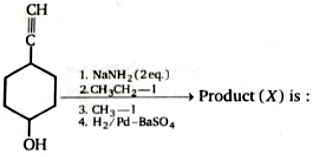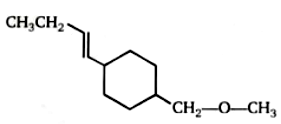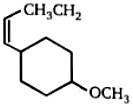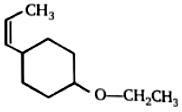In the given reaction ;
will be :
(a)
(b)
(c)
(d)
In the reaction sequence :
(B) will be :
(a)
(b)
(c)
(d)
In the given reaction, the product [P] is ;
(a)
(b)
(c)
(d)
Which of the following phrases are not correctly associated with SN1 reaction ?
(1) Rearrangement is possible
(2) Rate is affected by polarity of solvent
(3) The strength of the nucleophile is important in determing rate
(4) The reactivity series is tertiary > secondary > primary
(5) Proceeds with complete inversion of configuration
(a) 3,5
(b) 5 only
(c) 2,3,5
(d) 3 only
Which of the following is true about given graphs A and B?
1.
2.
3.
4.
In each of the following groups, which is the strongest (best) nucleophile ?
(I) (1) (2) (3)
(II) (1) (2) (3) in DMF
(III) (1) 

(a) I,3 ; II,3 ; III,2
(b) I,2 ; II,1 ; III,3
(c) I,1 ; II,2 ; III,1
(d) I,3 ; II,1 ; III,3

(a)
(b)
(c)
(d) None of these
Which of the following reaction is an elimination reaction ?
(a)
(b)
(c)
(d) Both 1 and 2
From each of the following pairs select the compound that will react faster with sodium iodide in acetone :
Pair-A : (1) 2-Chloropropanne (2) 2-Bromopropane
Pair-B : (3) 1- Bromobutane (4) 2-Bromobutane
(a) 1,3
(b) 1,4
(c) 2,3
(d) 2,4
Among the given halides, which one will give same product in SN1 and SN2 reactions
(a) (III) only
(b) (I) & (II)
(c) (III) & (IV)
(d) (I),(III) & (IV)
Product(s) formed during this reaction is/are :
(a)
(b)
(c)
(d) Both 1 & 2
Anisole
Which of the following compounds would react faster with NaCN in an SN2 reaction ?

The reaction
proceeds by the _____ mechanism
(1) SN1
(2) SN2
(3) SE2
(4) None of these

Reaction of R-2-butanol with p-toulenesulphonyl chloride in pyridine followed by reaction with LiBr gives :
(1) R-2-butyl bromide
(2) S-2-butyl tosylate
(3) R-2-butyl tosylate
(4) S-2-butyl bromide
The compound which undergoes reaction most rapidly is :
Addition of KI accelerates the hydrolysis of primary alkyl halides because :
(1) KI is soluble in organic solvents
(2) the iodide ion is a weak base and poor leaving group
(3) the iodide ion is a strong base
(4) the iodide ion is a powerful nucleophile as well as a good leaving group
; Major product (A) is :
(1)
(2)
(3)
(4)
What is the major product obtained in the following reaction ?

(a)
(b)
(c) Both (a) and (b)
(d) None is correct
; Major product of the reaction is :
| 1. |  |
| 2. |  |
| 3. |  |
| 4. |  |
Products (A) and (B) in the given below reactions, respectively, are:

| (A) | (B) | |
| 1. |  |
 |
| 2. |  |
 |
| 3. |  |
 |
| 4. | None of the above | |
Most reactive compound towards is :

1. 
2. 
3. 
4. 
Following reaction is an example of :+
(1) reaction
(2) reaction
(3) Electrophilic addition
(4) SN-NGP
The major product of the following reaction :